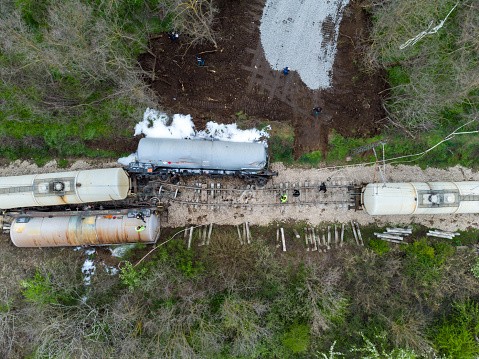
More than a year after the freight train disaster in Ohio, its aftermath has spread much farther than initially expected.
Train Derailment Incident
At about 8:55 p.m. on February 3, 2023, a train derailment disaster involving a Norfolk Southern freight train happened in East Palestine, Ohio, less than one mile (1.6 kilometers) from the Pennsylvania border. Fifty train cars were involved in the incident, of which cars were derailed and at least 11 were carrying a variety of toxic materials.
The derailed cars include those that carry butyl acrylate, vinyl chloride, and benzene, among other harmful substances. After the incident, some of these chemicals were released into the environment. Meanwhile, a subsequent fire burned for many days and damaged other cars.
To prevent an explosion, authorities performed a controlled burn of the chemicals, sending up a plume of black smoke. Experts suspect that this smoke likely contained hazardous chemicals, such as phosphine gas which was used in World War I as a chemical weapon.
There were a lot of reports of strong odors and contaminated water during and after the fire. The US Environmental Protection Agency (EPA) conducted atmospheric monitoring and measured significant concentrations of many chemicals.
READ ALSO : Ohio Train Derailment Causes Horrific Toxic Environmental Impacts, Sickness, Animal Deaths
Far-Reaching Fallout
Experts have mapped just how far this hazardous waste has traveled and published their findings in the paper "Widespread impacts to precipitation of the East Palestine Ohio train accident." It was found that the disaster has spilled toxic chemicals into the environment up to 540,000 miles (869,046 kilometers).
In the new study, it was discovered that after the disaster, the inorganic pollutants spread far and wide. The researchers detected unusually high soil pH (alkaline) which was recorded in rainfall across a vast region of the US. They also found abnormally high levels of chloride ions.
The exceptionally elevated alkali and alkaline earth metals exceed the 99th percentiles of the last decade of measurement. In addition, high concentrations of potassium, calcium, sodium, and ammonium ions were detected in various locations following the derailment.
The scope of the pollutants spans 16 US states surrounding the site in East Palestine, Ohio, affecting one third of the population in the country (110 million). The traces of inorganic chemicals released during the tragedy likely impacts southern Ontario and manu the Laurentian Great Lakes.
From their estimate, the research authors conclude that the impacted area encompassed 14% of the US land area. At this level, 19 sites had at least one chemical compound in the 99th percentile, while 8 areas had 4 or more substances in the 99th percentile.
The presence of these chemicals in precipitation could have a number of damaging effects on the local plants and animals. According to David Gay from the National Atmospheric Deposition Program (NADP), all of these pollutants are significant in the environment because their accumulation can impact the aquatic and terrestrial ecosystems in different ways.
The study also demonstrates the importance of a nationwide network for monitoring routine precipitation. The authors' observations also enabled them to analyze the regional atmospheric effect from the disaster as well as the subsequent response actions from the authorities.
RELATED ARTICLE : Almost 300 Harmful Chemical Substances Detected in Natural Gas; How Dangerous is Our Kitchen Stove to Our Health?
Check out more news and information on Toxic Chemicals in Science Times.
© 2025 ScienceTimes.com All rights reserved. Do not reproduce without permission. The window to the world of Science Times.











